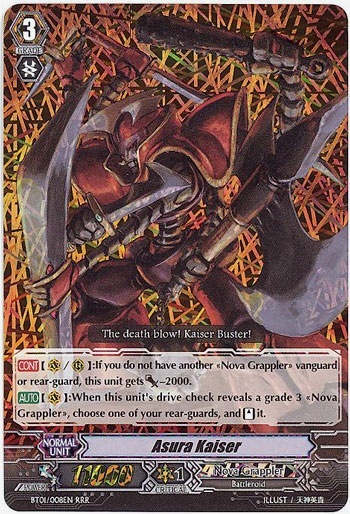 The Grade 3 Drive Checkers have been present in Vanguard ever since BT01 and the first 2 Trial Decks. Lead by Goku, Brigitte, and Asura Kaiser, more and more eventually came into action and offered new builds within all the clans to center around. But what makes them useful? A question that some had first joining, including me, all the way to veterans deciding on their next build to play with. So here's a rundown on what Grade 3 Drive Checkers have to offer for a fight.
The Grade 3 Drive Checkers have been present in Vanguard ever since BT01 and the first 2 Trial Decks. Lead by Goku, Brigitte, and Asura Kaiser, more and more eventually came into action and offered new builds within all the clans to center around. But what makes them useful? A question that some had first joining, including me, all the way to veterans deciding on their next build to play with. So here's a rundown on what Grade 3 Drive Checkers have to offer for a fight.To really understand how these cards work, we'd have to dive into probabilities and compare it to cards without this skill. Normally, when a Grade 3 Twin Drives, it's ability to pull triggers is based off 1/3rds. With this, they have a 4/9 chance to pull 0 triggers, 4/9 chance to pull 1 trigger, and a 1/9 chance to pull 2 triggers. Grade 3 drive checkers however increase viable targets in the deck to about half of the deck, so triggers are now based on 1/2s. 1/4 of the time, no triggers will appear. 1/2 of the time, only a single trigger will appear. Finally, 1/4 of the time, 2 triggers will appear. Visually, this all works like:
Twin Drive:
X X X X X X X X X X X X X X X X X X X X X X X X X X X X X X X X X X X X
Grade 3 checker's Twin Drive:
X X X X X X X X X X X X X X X X X X X X X X X X X X X X X X X X X X X X
Nothing revealed 1 target revealed 2 targets revealed
 Excuse the bright colors. Anywho, the X's here, when lined up, show that Grade 3 checkers have 12 X's of higher value in line with regular twin drive. Since this is out of 36 X's, that basically means that Grade 3 checkers have a viability 1/3 higher than normal.
Excuse the bright colors. Anywho, the X's here, when lined up, show that Grade 3 checkers have 12 X's of higher value in line with regular twin drive. Since this is out of 36 X's, that basically means that Grade 3 checkers have a viability 1/3 higher than normal.
Consider this for a moment. If hitting a target on the Twin Drive can be viewed as a +1, whether in raw advantage or auxiliary advantage, and Grade 3 checkers will hit targets at a 1/3rd greater amount, wouldn't this mean over the course of 3 turns, a Grade 3 checker will gain a net +1? Well, yes. In fact, this is the beauty behind Grade 3 checkers. For simply sitting on your Grade 3 Vanguard, you can net free card advantage.
This can be taken a step further. If you can marathon a fight for at least 6+ turns, you can draw out a free +2 in card advantage overall. Considering some of the biggest units in the game have to pay heavy costs for that kind of card advantage, Grade 3 drive checkers show up as prime examples of cost efficient cards that only succeed in netting you advantage for very few, if any, detriments. What makes this card advantage amazing is not only are you generating this card advantage, you are doing so for free. All your Berserk Dragons and Brutal Jacks and Rios and Blaster Blades all have clear access to all your resources that you have to devote practically nothing to your Vanguard. Not only will a Grade 3 drive checking deck have access to the card advantage a Vanguard can offer, but they'll also have the greatest possible deck performance a clan can offer thanks to all resources being able to be devoted into Rear-Guards.
To sum up, Grade 3 checkers really do have a lot to offer. For free +'s as the course of a match marches on, they really do offer a lot to a deck for being so flexible while not sacrificing much performance.
TehNacho, I think their is one major piece of information missing;
ReplyDeleteThe base chance of Drive Check doing something is 56%, correct? What does it increase to with a Grade 3 checker and the commonly used ratios? I chucked 36 and 9 in a percentage calculator, assuming 36 is cards left and 9 is the chance of not doing anything, I got 75% of checking something that effects the game.
It's not that high, is it?
'affects the game'
DeleteWow you are vague.
With 49 cards and 24 targets (Triggers+8 Grade 3s), the probability shoots up to about 74.5% to get a target within a Twin Drive.
Think of it like this. With 49 cards and 24 targets, it essentially looks like the chance to get a target with a single drive check is close to 1/2. This also means the probability to fail at getting a target is 1/2. Multiply 1/2 by 1/2 to get the probability of failing to get any target after [Twin Driving], and you should get 1/4. Finally, subtract that value from one to get the probability of getting anything other than complete failure (aka, at least one target from the Twin Drive), and the probability of getting at least one is now 3/4, or 75%.
tl;dr, yeah, it goes that high.